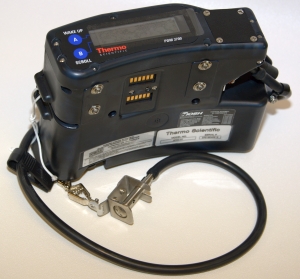Mining Feature: CPDM Helps Coal Miners Avoid Hazardous Dust
Friday, December 30, 2016
 Dynamic Technology Detects Hazardous Coal Dust in Minutes
Dynamic Technology Detects Hazardous Coal Dust in Minutes
Coal miners now have a breakthrough technology for reducing their exposure to hazardous coal dust. Thanks to a National Institute for Occupational Safety and Health (NIOSH) technology partnership, miners are empowered with a new wearable device—the continuous personal dust monitor (CPDM). The CPDM warns miners when they encounter hazardous dust concentrations in the air they’re breathing. Since MSHA mandated CPDM use in February 2016, coal dust exposure has dramatically reduced. The CPDM could be key to preventing coal workers’ pneumoconiosis, or “black lung.”
Miners who suffer from black lung experience lifelong and irreversible breathing problems, often leading to premature death. Alarmingly, an especially severe form of the disease, progressive massive fibrosis (PMF), is resurfacing. NIOSH researchers documented this trend in the December 16 issue of CDC’s “Morbidity and Mortality Weekly Report.” That same week, NPR’s “All Things Considered” confirmed the resurgence in PMF with cases from 11 black lung clinics. The U.S. Department of Labor’s Black Lung Program has paid over $43 billion in compensation to black lung sufferers since 1970, and over $289 million in 2015 alone.
The CPDM detects hazardous coal mine dust in the miner’s breathing zone, reporting this information on a frequently updated digital readout. Miners can wear the portable CPDM for their entire shift. The device specifically measures respirable dust particles capable of embedding in lung tissue and causing black lung.
“This instrument revolutionizes sampling and puts the power in the hands of miners and mine operators,” said Jay Colinet, principal mining engineer at NIOSH.
 Before the CPDM, mines had to collect samples on a filter and send them to a lab, where the samples were analyzed for hazardous dust. Shipping and lab time often took weeks—meanwhile, a miner wasn’t warned of any ongoing dust exposure. The CPDM reduces this time to minutes and delivers the exposure information directly to the miner.
Before the CPDM, mines had to collect samples on a filter and send them to a lab, where the samples were analyzed for hazardous dust. Shipping and lab time often took weeks—meanwhile, a miner wasn’t warned of any ongoing dust exposure. The CPDM reduces this time to minutes and delivers the exposure information directly to the miner.
When miners see a hazardous level on the CPDM readout, they can immediately move to an area where there’s less dust or take action to control the dust at the source. As reported to NIOSH by mine officials, miners are indeed moving away from high-dust areas based on their CPDM readout. Miners working different shifts even compete to achieve lower CPDM dust readings. One company reported a 20% reduction in dust concentrations after implementing the CPDM.
Recent dust sample data confirm a substantial decline in exposures since the CPDM was mandated. The percentage of samples exceeding the MSHA dust exposure limit declined from 3.1 percent to 0.3 percent—a 90 percent reduction. Such a dramatic reduction points to miners using the CPDM to lower their dust exposure, which directly reduces their risk of developing black lung disease.
Thermo Fisher Scientific commercialized the CPDM in its PDM3700 Personal Dust Monitor. This technology breakthrough represents more than a decade of research by NIOSH and several partners, including the Department of Labor’s MSHA and mining industry stakeholders. MSHA recognized the CPDM’s effectiveness by mandating its use for compliance sampling starting on February 1, 2016. Compliance sampling has been required since the Federal Coal Mine Health and Safety Act of 1969, but could previously only be done through lab analysis.
Black lung prevention is a top priority for the NIOSH Mining Program. Decades of research produced many effective dust control technologies for mines, including water sprays, protective air curtains, and air scrubbers. These solutions are detailed in the NIOSH publication, “Best Practices for Dust Control in Coal Mining,” and in many other resources available from the Program’s website. The Program’s ongoing research aims to deliver even more effective solutions to eradicate black lung.
- Control of Respirable Dust
- Enhanced Utilization of Personal Dust Monitor Feedback
- Investigation into Dust Exposures and Mining Practices in Mines in the Southern Appalachian Region
- Respirable Dust
- Respirable Dust Control for Surface Mines
- Respirable Dust Control Methods on Continuous Mining Operations
- Respiratory Diseases
- Silica Adds to Respirable Dust Concerns: What If You Could Know the Silica Dust Levels in a Coal Mine After Every Shift?
- Trend in Black Lung Cases Concerns NIOSH Researchers
- Using Real-Time Respirable Dust Monitors to Address the Silica Health Hazard in Mining